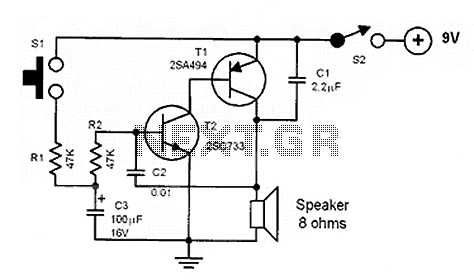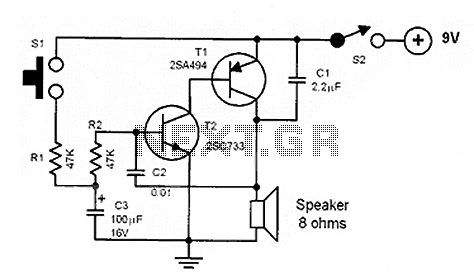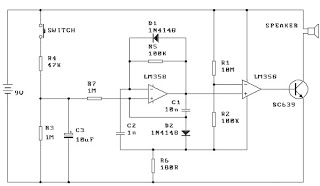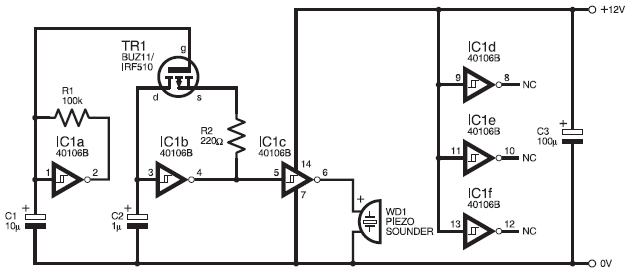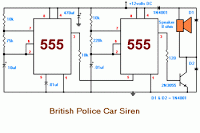
7400 Siren

Two NAND gates are utilized in the oscillator configuration, while two additional NAND gates serve as control elements. To modify the two-tone speed, the 220 µF capacitors can be replaced with larger values for slower operation. For frequency adjustments of the oscillator, the 0.2 µF and 0.1 µF capacitors can be varied, and the resistance value of R1 can be increased. To adjust the frequency range between the two notes, the 1.5 kΩ resistor should be altered.
The circuit employs two NAND gates configured as an oscillator, which generates a square wave signal fundamental for producing audio tones. The oscillation frequency is primarily determined by the capacitors and the resistor in the timing network. In this configuration, the two NAND gates function as inverter stages, where the feedback loop formed by the resistors and capacitors dictates the oscillation frequency.
The use of 220 µF capacitors allows for a specific tone speed, which can be modified by substituting these capacitors with larger values. This adjustment results in a slower oscillation rate, effectively lowering the pitch of the generated tones. The capacitors of 0.2 µF and 0.1 µF are critical for fine-tuning the frequency; changing these components alters the charge and discharge times, thus affecting the output frequency of the oscillator.
R1 plays a vital role in the timing circuit; increasing its resistance will extend the oscillation period, thereby lowering the frequency. The 1.5 kΩ resistor is crucial for adjusting the frequency range between the two generated notes. By altering this resistor, the circuit can shift the pitch range, allowing for a broader spectrum of tones to be produced.
Overall, this oscillator circuit is a versatile design that can be easily modified by changing capacitor and resistor values, providing flexibility in sound synthesis applications.Two NAND gates are used for the oscillator, and two as the control. If the two-tone speed needs to be altered, the 220 µ capacitors can be changed Oarger for slower operation). If the frequency of the oscillator is to be changed, the 0.2 and 0.1 /iF capacitors can be varied and the value of Rl can be increased.
To change frequency range between the two notes, alter the 1.5 k (1,500) resistor= To change frequency range between the two notes, alter the 1.5 k (1,500) resistor. 🔗 External reference
The circuit employs two NAND gates configured as an oscillator, which generates a square wave signal fundamental for producing audio tones. The oscillation frequency is primarily determined by the capacitors and the resistor in the timing network. In this configuration, the two NAND gates function as inverter stages, where the feedback loop formed by the resistors and capacitors dictates the oscillation frequency.
The use of 220 µF capacitors allows for a specific tone speed, which can be modified by substituting these capacitors with larger values. This adjustment results in a slower oscillation rate, effectively lowering the pitch of the generated tones. The capacitors of 0.2 µF and 0.1 µF are critical for fine-tuning the frequency; changing these components alters the charge and discharge times, thus affecting the output frequency of the oscillator.
R1 plays a vital role in the timing circuit; increasing its resistance will extend the oscillation period, thereby lowering the frequency. The 1.5 kΩ resistor is crucial for adjusting the frequency range between the two generated notes. By altering this resistor, the circuit can shift the pitch range, allowing for a broader spectrum of tones to be produced.
Overall, this oscillator circuit is a versatile design that can be easily modified by changing capacitor and resistor values, providing flexibility in sound synthesis applications.Two NAND gates are used for the oscillator, and two as the control. If the two-tone speed needs to be altered, the 220 µ capacitors can be changed Oarger for slower operation). If the frequency of the oscillator is to be changed, the 0.2 and 0.1 /iF capacitors can be varied and the value of Rl can be increased.
To change frequency range between the two notes, alter the 1.5 k (1,500) resistor= To change frequency range between the two notes, alter the 1.5 k (1,500) resistor. 🔗 External reference
